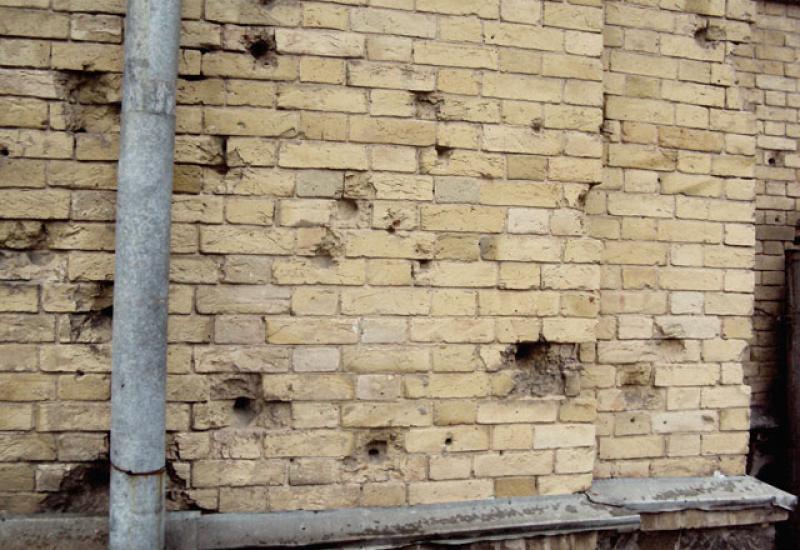The wall of the old section plant “Arsenal”, beaten by cannon and rifle shots, were for a long time the visiting card of Kiev, together with the monument to Bogdan Khmelnitsky, St. Andrew's Church and Kiev-Pechersk Lavra complex.
This - visual traces of the defeat of the uprising of the Kiev workers against the Central Council in January 1918. A three-inch gun mounted on the pedestal of the monument of the former Colonel Ivan Iskra and general judge Basil Kochubei - now it is a monument to the heroes-Arsenal workers. Now this place is already removed from the number of mandatory inspection of objects - is too ambiguous attitude of people to the events of the first half of the twentieth century, both in Ukraine and abroad. However, nevertheless, these events are the history of our people, and the potholes on the old walls - a silent reminder that this history never was simple, and sometimes it was extremely cruel.
However, not everyone knows that the past has left the same marks on the oldest KIP building - the fourth. The shot traces can be seen only on one side of the wall - one that is closer to the building №1 and can be clearly seen from the central alley. It is worth noting that all the wall has undergone the shelling because bricks smashed or mutilated by shells, bullets or buckshot are located not the only deaf part of it, but also among its windows.
Whose shots left such a burr on the wall, who is here and when he led the fight is unknown.
These may be signs of the destruction of tsarist armies December 16 1905 the famous Shuliavka Republic.However, although we know that there were more than 2000 soldiers, Cossacks and police, there was no any new about use of cannons during this event. Moreover the headquarters of the rebels were in the Institute’s main building, so either we do not know something; either the building was fired not at that time.
It is possible that this is clear evidence of the fierce fighting for Kiev in November 1943. It is known, that the tanks of 38th army of the 1 Ukrainian Front were the first to enter in the capital of Ukraine from the direction of Zhitomir. The battle was at the area of Brest-Litovsk highway (now Peremogy avenue). The commander of the first tank, Guard Petty Officer Nikiphor Sholudenko was killed in the area of the plant “Bolshevik”. It is therefore possible that the battered brick walls of the fourth building KPI are traces of the German defense, because their location indicates that the fire was in the direction of the highway. However, there are no arguments pro or contra this version.
Seems the most likely is an assumption that in a conversation with the staff of "KP" stated head of the department of technical training department of educational work "KPI" Victor Lazarenko. He noted that these marks could appear Dec. 14, 1918, when the Directory changed the regime Hetman Skoropadsky. The Petliura troops entered the city - during the battle, which outstanding writer, originally from Kiev Mikhail Bulgakov described in the novel “The White Guard”. Those who at least once flipped through the pages of this book certainly will not forget this place:
"... The points of horses appeared, shrapnel began to burst high in dense, promising snow sky. Equestrian points gathered in tape and capturing the entire width of the highway began to swell, turned black, grew and rolled on Nai-Tours. There is shutters’ crash on circuits of cadets. Nye took out a whistle, a shrill whistle and shouted:
- Direct on cavalry! .. Salvos… Fire...!
Spark took the gray circuits, and the cadets sent Kozyr the first salvo. Three times then a piece of cloth was torn from the sky to the walls of the Polytechnic Institute, and three times reflected lashing thunder, shot the best Tours battalion. Horses’ black tape broke away, scattered and disappeared from the highway. "
Note that Mikhail Bulgakov wrote a work of art rather than a chronicle of events. And the fight, which was attended by cadets under Colonel Nai-Tours - is, in fact, only one of the fighting scenes, because the true extent of the collision were wider than in the novel. However, given how carefully treated writer to detail in this, perhaps, one of the most Kiev in the world literature works, the accuracy with which describes the historical background, it is possible with almost absolute certainty that everything in life was as written in book. Incidentally, in the above-cited passage is given and the answer to the question why the wall has potholes from the shots, not only rifles, guns and - pay attention to the memory of tears shrapnel.
... Of course, there is no full of confidence in one of these versions. And perhaps some of our readers have reliable information about when and exactly who was fighting on the territory of the KPI. For such information, "Kyiv Polytechnic" glad to provide space on their pages.

